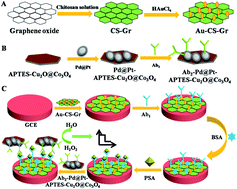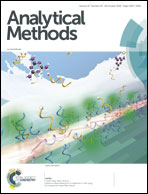An electrochemical immunosensor based on a multiple signal amplification strategy for highly sensitive detection of prostate specific antigen†
Abstract
A sandwich-type electrochemical immunosensor was developed based on a multiple signal amplification strategy. To enable this objective, pompon-like palladium@platinum nanoparticles were attached onto a 3-aminopropyl-triethoxysilane functionalized cuprous oxide@cobalt oxide nanocomposite (Pd@Pt-APTES-Cu2O@Co3O4) by constructing Pt–N bonds. The nanocomposite exhibited better electrocatalytic activity towards the reduction of hydrogen peroxide than each component and was used as a multiple signal amplification label to capture secondary antibodies due to its splendid electrochemical performance. Meanwhile, a gold nanoparticle incorporated chitosan-graphene nanocomposite solution (Au-CS-Gr) was modified on a glassy carbon electrode and employed as an electron transfer facilitator and primary antibody carrier. The proposed electrochemical immunosensor showed a wide linear range from 0.01 pg mL−1 to 100 ng mL−1 and a low detection limit of 2.0 fg mL−1 for quantitative detection of PSA. It also exhibited high sensitivity, good stability and acceptable reproducibility. Furthermore, a favorable result was obtained when the proposed method was applied to the analysis of human serum samples, which indicated its potential application in clinical analysis of tumor markers.

- This article is part of the themed collection: Electrochemistry for health applications


 Please wait while we load your content...
Please wait while we load your content...